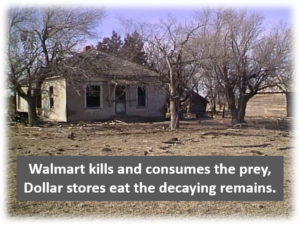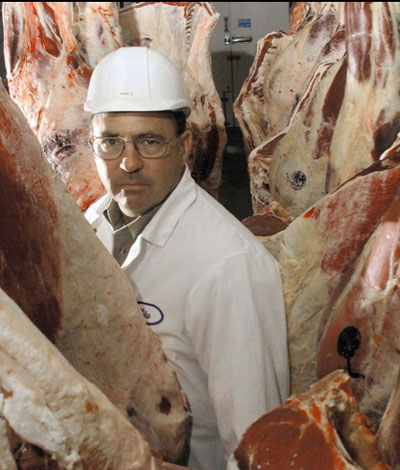March 29, 2002
Economists Spread Meat Packer Propaganda
By Mike Callicrate
“Concentration in the beef processing sector has increased dramatically over the last quarter century,” says Kansas State University agricultural economist, big meat packer expert witness and defender, Jim Mintert. Like most deceptive people and their illusions, there is usually at least a bit of reality and truth in their message.
In his recent incoherent rambling in Feed Lot magazine, “Efficiency Gains in Beef Processing have Been Beneficial,” Mintert references other equally misguided economists, Gary Brester and John Marsh, from Montana State University. Mintert is right about four firm concentration exceeding 80 percent, but that is about as far as his credibility goes.
To cattlemen, legislators, and industry leaders who are not either intellectually challenged, or like Mintert, corrupted by meat packer money, the lies of the big packers spouted by their economist/analyst mouthpieces are now crystal clear and are becoming thinner smoke screens once concealing what has now become the total economic collapse of the cattle industry.
Often the most obvious, simple explanation is correct while the more complicated “inflation adjusted” answer is the smoke screen. Mintert contends, “Changes in meat packing technology actually generated cost savings that led to a reduction in inflation adjusted live-to-wholesale beef price spreads which in turn, boosted inflation adjusted cattle prices.” This convoluted, mind-numbing statement is an example of arbitrarily assigning your own cause, the one that most benefits yourself and your associates, to an effect…The price goes down, so there must be an oversupply, it couldn’t be price fixing. Translated, this means: If the packer reduces costs he can either pay more for his raw material (cattle) or sell meat for less, or both, or neither, whichever he is motivated to do.
To fully understand Mintert’s deception of what he wants us to think is improved efficiencies, it may be useful to know how the meat packer reduces costs, which is only one of the possible factors potentially causing a reduction in live-to-wholesale price spreads. We should also try to understand what really motivates the behavior. The most obvious factor improving efficiency has been turning up the chain speed (400 head/ hour). This increases throughput and employee (Illegal, non-English speaking economic refugees) per hour output while reducing cost per unit, but unfortunately it also increases worker anxiety, turnover, injury rates, inhumane treatment, and pathogen contamination. And incidentally, President and CEO, Robert Peterson’s bonus calculation has been based on the number of steers and heifers slaughtered. How simple, output and personal income increased by the simple turn of a switch.
“The researchers also conclude that changes in cattle production technology specifically increased dressed cattle weights,” and consider this a large negative impact on cattle prices. Odd the same researchers, who also tout the “cattle cycle”, don’t find a similar negative effect from beef and cattle imports that now represent nearly 20 percent of total U.S. consumption.
Again the wrong cause assigned to the effect. Cattle feeders are no more responsible for the increase in slaughter weights than they are for the increase in beef imports that are displacing U.S. production, the lack of country of origin labeling, or the lack of inspection. Packers and retailers are dictating these factors. The bigger the cattle, the more meat will be in the truck at the end of the day. It costs the same to process a big steer as it does a small heifer. Feeders can’t sell to packers who are processing their own livestock rather than buying them on a competitive market.
Cattle feeders have been left no choice but to select genetics for heavier muscled, leaner cattle (Beasts of burden a.k.a. “Mule meat”), that are less likely to produce over fat cattle that suffer the deep discounts and high feeding costs associated with over feeding, even though the result is lower quality, less desirable meat. Additionally, cattle feeders, in order to compete, are forced to use hormone implants to reduce cost and increase carcass weights even though implants are proven to decrease meat tenderness. Of course, a non-competitive, monopolized food system doesn’t care that the informed consumer doesn’t want synthetic hormones or sub-therapeutic antibiotics used, or that they are fearful of the new industrialized, factory system of food production, or that a cowboy boot for dinner may be preferable to a Tyson-IBP/Wal-Mart chemically treated steak.
Just needle it, pump it, blade it, chemically treat it, and force-feed it to the world…just like pork and chicken! For more cost savings (not to be shared with producers) the packer-processor, through the technology of Advanced Meat Recovery, a.k.a. AMR, salvages and grinds the bones and marrow along with bits and pieces of meat, spinal and nervous tissue for blending with domestic and imported ground beef. In an affront to the obvious risks, this extremely dangerous (Mad Cow risk and pathogen introduction) manufacturing approach to beef processing has resulted in the lowest quality meat in our history.
Now, where do the benefits from the so-called cost savings go? If you held the position of extreme market power of IBP and their cartel partners, and had the choice of paying producers more for finished cattle or selling meat for less to your partner Wal-Mart or Krogers, what would you do? Again, contrary to Mintert and his friends, there is a simple answer. For the first time in history, retailers like Wal-Mart, Kroger’s, Safeway, Albertson’s, and McDonald’s are big enough and bully enough to dictate terms to packers and processors.
John Tyson asked me a year ago when I was explaining the IBP anti-trust case to him, “Why don’t you sue Wal-Mart? They are the problem, not us. They tell us what they will pay and we have no choice but to buy from you cheaper.” Because cattle owners are considered “indirect sellers” to Wal-Mart, they are barred in most states, by the precedent setting 1977 Illinois Brick decision from relief. A 1979 case in the fifth circuit court held that cattle feeders failed to establish that retail grocers engaged in a conspiracy to fix wholesale beef prices because the cattle feeders did not sell directly to retailers, but to beef packers. Consequently, producers are now receiving the lowest share of the consumer fresh beef dollar in history, being denied market access, and going broke as packers continue to manipulate the markets. Is this unfairness and suffering acceptable in the U.S., a country founded on freedom and home to the biggest and best market for beef in the world?
“Work will set you free,” read the inscription above the entrance to the efficiently engineered death camp at Auschwitz, Poland. Consider how this scene, described by Nathan Gray, compares to the surviving towns in rural America: “At first, as you stroll through the gates of Auschwitz, it’s like a mini village of brick buildings. It could so easily be Pleasantville, all the same style buildings happily built in neighborly unison, but something is just not quite right.” Today’s lie in agriculture is that efficiencies, economies of sale (a concentrated, centrally planned economic system), and globalization will set you free.
History teaches time and again the greatest threat to a free society has always been concentration of power and wealth into the hands of a few. Educators disregarding the lessons of history have essentially promoted concentration, consolidation and the economic enslavement of producers. They falsely blame the already desperate farmers and ranchers for the loss of their families’ homesteads. They mentally condition the public into thinking the water is warm and perfect for showering as the deadly gas of monopoly control is turned on production agriculture, rural communities, and our food system…disposing the remains into the global economic sewer with many others forced to produce below their costs for benefit of a few powerful multinational corporations.
How safe and secure is any food system that is controlled by a handful of colluding, profit driven multinational corporations operating outside the law, importing food from wherever they can source it the cheapest, while extracting monopoly profits from slave labor, the environment, and consumers, creating an environment of permanent poverty and unrest around the globe?
Is this the kind of economic system that promotes continuous beneficial wealth creation, safe, sustainable, reliable food production, global peace, and prosperity? Perhaps we should ponder this question as we consider patronizing global predators like Wal-Mart instead of a local family owned business, or as we consider eating the next manufactured, chemically treated, and mechanically tenderized steak or fast food hamburger at a national restaurant chain rather than enjoying real food served at home or at a locally owned restaurant.












